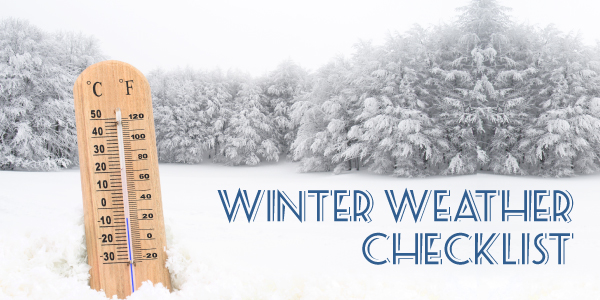
As we continue to experience freezing weather all across the country, it’s important to ensure your home is prepared for the plummeting temperatures.
A frozen pipe or collapsed roof will not only cost thousands of dollars in repairs to either you or your insurance company, but it will almost certainly displace you and your family from your home until the work is complete.
Below you will find a few tips on preventing potential damage to your property from freezing weather.
If you would like to know how your homeowners insurance policy would respond to the scenarios below, please feel free to give our office a call.
WINTER WEATHER MAINTENANCE CHECKLIST
- Fresh snow: 10-12 in. of new snow is equal to 1 inch of water, or about 5 lbs. per square foot of roof space, so you could have up to 4 ft. of new snow before the roof becomes stressed.
- Packed snow: 3-5 in. of old snow is equal to 1 inch of water, or about 5 lbs. per square foot of roof space, so anything more than 2 ft. of old snow could be too much for your roof to handle.
- Total accumulated weight: 2 ft. of old snow and 2 ft. of new snow could weigh as much as 60 lbs. per square foot of roof space, which is beyond the typical snow load capacity for most roofs.
- Ice: 1 inch of ice equals 1 ft. of fresh snow.
A two-step approach is the most effective way to reduce the size of ice dams. First, keep the attic floor well insulated to minimize the amount of heat from within the house that rises into the attic. Second, keep the attic well ventilated so that the cold air outside can circulate through it and reduce the roof system’s temperature. The colder the attic, the less thawing and refreezing on the roof.
Step One: Insulating the attic. The attic floor should be airtight, have sufficient insulation, and keep the transfer of heat from the downstairs to the attic at a minimum. Even a well-insulated attic floor may have several openings that can permit warm air from below to seep up into the attic. For instance, these items may cut through the attic floor:
- Exhaust pipes and plumbing vents
- Fireplace and heating system chimneys
- Light fixtures
Seal all openings around these penetrations, but be careful not to block attic vents with insulation. Additionally, pull-down stairs or a set of regular stairs leading up to the attic from the lower level can be avenues for rising heat. Weatherstripping around the edges of the attic access door and insulation on the door’s attic side should minimize the passage of heat to the attic.
Step Two: Ventilating the attic. There are several ways to ventilate your attic. To the extent that household heat penetrates the attic, it should be able to rise and escape through, for instance, a ridge vent, while soffit or eave vents pull in cold air to replace it. Proper ventilation of the attic to let cold in, together with air sealing and insulation on the attic floor to help keep household heat out of the attic, work to minimize the likelihood of ice dams.
- Insulate all attic penetrations.
- Ensure proper seals on all doors and windows.
- Seal all wall cracks and penetrations, including electrical conduit and other utility service lines.
- Place a monitored automatic excess flow switch on the main incoming domestic water line to provide early detection of a broken pipe or valve when the space is unoccupied.
- Windows and doors
- Vents and fans
- Plumbing
- Air conditioners
- Electrical and gas lines
- Mail chutes
